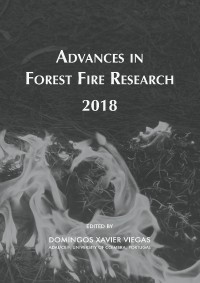Please use this identifier to cite or link to this item:
https://hdl.handle.net/10316.2/44603| DC Field | Value | Language |
|---|---|---|
| dc.contributor.author | Santos, João Francisco Labres dos | |
| dc.contributor.author | Batista, Antonio Carlos | |
| dc.contributor.author | Tres, Andressa | |
| dc.contributor.author | Tetto, Alexandre França | |
| dc.contributor.author | Kovalsyki, Bruna | |
| dc.date.accessioned | 2018-11-09T15:03:09Z | |
| dc.date.accessioned | 2020-09-06T17:31:39Z | - |
| dc.date.available | 2018-11-09T15:03:09Z | |
| dc.date.available | 2020-09-06T17:31:39Z | - |
| dc.date.issued | 2018 | - |
| dc.identifier.isbn | 978-989-26-16-506 (PDF) | |
| dc.identifier.uri | https://hdl.handle.net/10316.2/44603 | - |
| dc.description.abstract | In order to minimize the incidence and magnitude of fires, preventive silviculture proposes the establishment of fuel breaks, which is strips of vegetation with species of lower flammability than those of the main cultivation, with the aim of reducing or avoiding fire spread. The objective of the study was to evaluate the flammability and combustibility of eight ornamental species by means of cluster analysis, and indicate their potential for use as fuel breaks. Flammability was determined according to the methodology recommended by Valette (1990) and Petriccione (2006). For each evaluated species, 50 firing repetitions were performed in the epirradiator, each one consisting of 1 ± 0.1 g of fine green combustible material (Ø < 0.7 cm). In the tests the following combustion characteristics were analyzed: Ignition Time (IT), Ignition Frequency (IF), Duration of Combustion (DC) and Flame Height (FH). The fire behavior components were measured according to the methodology presented by Batista and Biondi (2009). The experimental burns were carried out in 1 m² (1 m x 1 m) plots, with a load of 1 kg.m² for all treatments. The following parameters were analyzed: Flame Height (FHh), Speed of Propagation (SP) and Residual Material (RM). The Lower Calorific Value (LCV) was determined with an isoperibol calorimeter, following the standard of ABNT NBR 8633/1984 and was expressed by calories per gram (kcal.kg-1). The Flammability Value (FV) was obtained according to the methodology applied by Vallete (1990) and the fire intensity was estimated using the Byram equation (1959). The parameters IF, IT, DC and FH of flammability and FHh, SP, RM and LCV of combustibility were submitted to cluster analysis. Schinus terebinthifolius and Bougainvillea glabra were the species that presented the lowest values of flammability and combustibility being classified in the null class, as well as Rhododendron simsii in the low classification class. Jasminum mesnyi has low combustibility, but high flammability, not being indicated for composing a fuel break. Viburnum odoratissimum showed low ignition capacity, but its combustibility presented superior parameters when compared to Pinus taeda. Magnolia grandiflora, even with some inferior parameters than those of P. taeda, has the lowest IT, being highly flammable and not recommended for use in fuel breaks. S. terebinthfolius, B. glabra and R. simsii are the species indicated for use as fuel breaks. | eng |
| dc.language.iso | eng | - |
| dc.publisher | Imprensa da Universidade de Coimbra | por |
| dc.relation.ispartof | http://hdl.handle.net/10316.2/44517 | por |
| dc.rights | open access | - |
| dc.subject | forest fires | eng |
| dc.subject | preventive silviculture | eng |
| dc.subject | calorimetry | eng |
| dc.subject | combustible material | eng |
| dc.title | Flammability and combustibility of potential species for use as fuel breaks | por |
| dc.type | bookPart | por |
| uc.publication.firstPage | 788 | - |
| uc.publication.lastPage | 793 | - |
| uc.publication.location | Coimbra | por |
| dc.identifier.doi | 10.14195/978-989-26-16-506_86 | - |
| uc.publication.section | Chapter 4 - Fire at the Wildland Urban Interface | por |
| uc.publication.digCollection | PB | por |
| uc.publication.orderno | 86 | - |
| uc.publication.area | Ciências da Engenharia e Tecnologias | por |
| uc.publication.bookTitle | Advances in forest fire research 2018 | - |
| uc.publication.manifest | https://dl.uc.pt/json/iiif/10316.2/44603/204303/manifest?manifest=/json/iiif/10316.2/44603/204303/manifest | - |
| uc.publication.thumbnail | https://dl.uc.pt/retrieve/11059595 | - |
| uc.publication.parentItemId | 55072 | - |
| uc.itemId | 68870 | - |
| item.grantfulltext | open | - |
| item.fulltext | With Fulltext | - |
| Appears in Collections: | Advances in forest fire research 2018 | |
Files in This Item:
| File | Description | Size | Format | |
|---|---|---|---|---|
| flammability_and_combustibility_of_potential_species.pdf | 830.12 kB | Adobe PDF |  |
Items in DSpace are protected by copyright, with all rights reserved, unless otherwise indicated.
